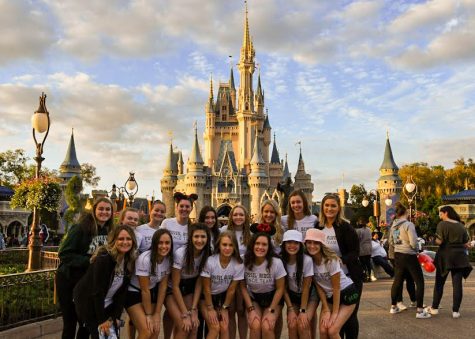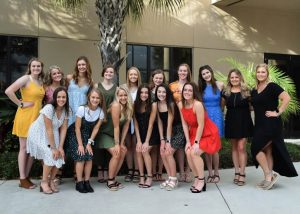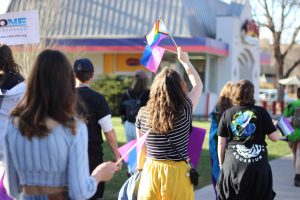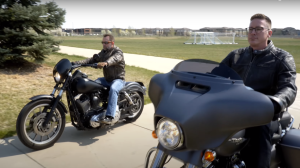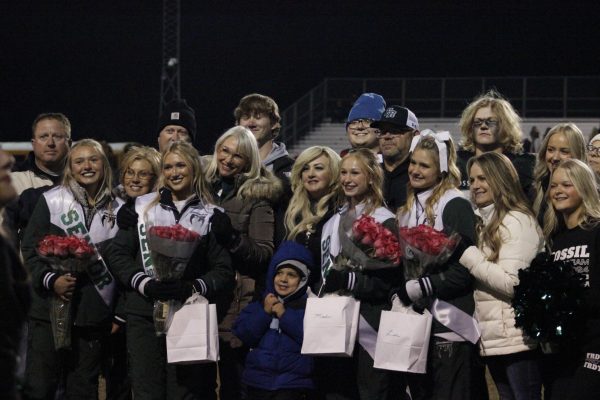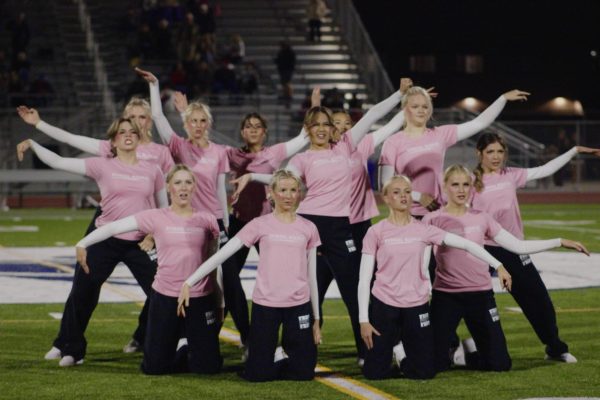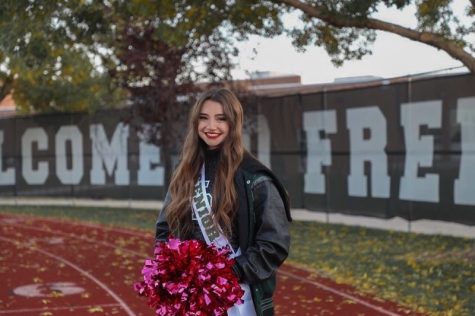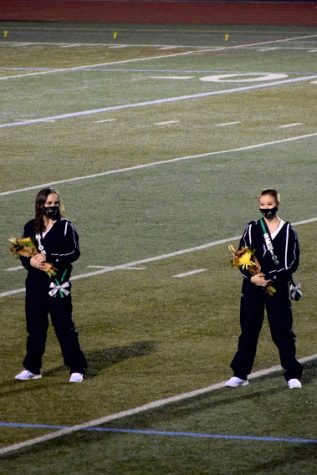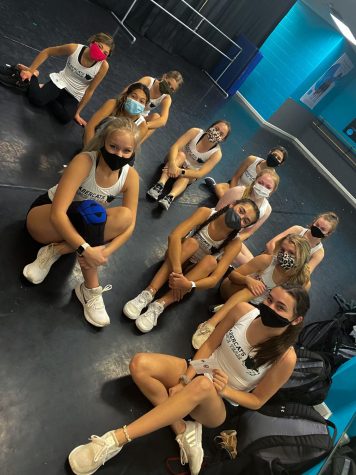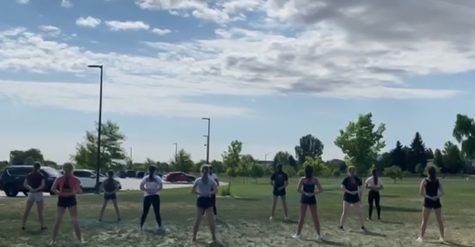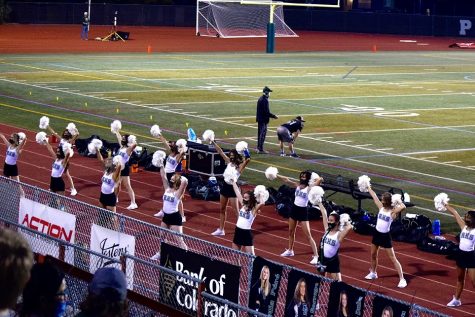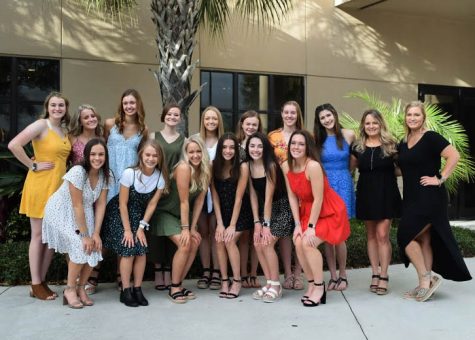Surprise adversity does not stop dancers
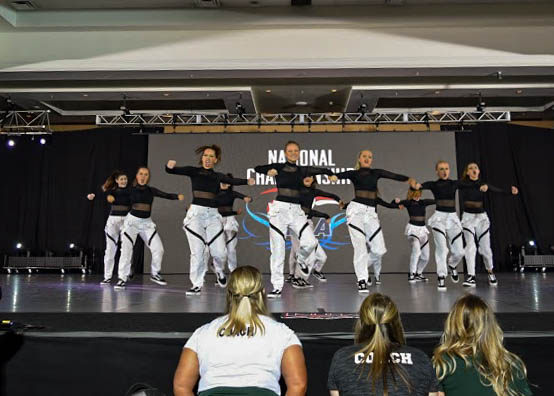
The coaches watch as hip-hop is competed. This dance was very high on the difficulty level and very physically demanding.
March 27, 2020
Since tryouts in May of 2019, Fossil Ridge High School’s dance team, my dance team, have prepared for our entire season, including for nationals. We work for an entire season, leading up to one finale, getting to compete in Orlando, Florida. Most students do not realize our season is ten months long. We work for almost the entire year, almost every day, cleaning old routines and learning new ones.
Over the summer, the team participated in a camp hosted by the Nation Dance Association, otherwise known as the NDA. There, we learned five routines in a three day intensive camp, dancing around ten hours each day. On the second day, we were evaluated on a dance that our whole season depended on. Based on our performance, the instructors could choose to give us a bid to the national competition. We had to perform with smiles and good expressions, remembering the routine perfectly and working as a team. We waited anxiously for the next day, when the bid would be announced in a showcase in front of our families. We received our bid, and everyone cheered. The road to nationals began.
We learned two routines in August to be competed throughout the entire season. The first routine was hip-hop, which many dancers were ecstatic to learn. After competing in pom last season, we were excited to improve our skills in another style. Our second routine was in a category of jazz, which includes traditional, sassy jazz, lyrical, and contemporary dancesㅡwe did lyrical. Unlike the mix of songs in hip-hop, we danced to one song, “To Build a Home” by The Cinematic Orchestra. The song, all about the sadness and hope of finding comfort in difficult times, created a beautiful and emotional dance. After two long days of learning choreography, preparations began for the competition season. Both dances were choreographed by Marissa Ferrin, who we grew a close bond to as she came in to teach and condition us in a practice each week.
Before the end of the first semester, we competed in a total of four competitions—Front Range League, UDA Regionals, NDA Regionals, and CHSAA State Spirit. Competing at state was a big highlight of our season. We were only allowed to bring one routine, so we brought hip-hop to the floor. We dedicated months of practice into this routine, just to clean it. This included making sure everyone’s arms were at the exact same angles, feet placement was the same, trick timing was together, and every movement looked as if the team was one person.
Leading up to nationals were some of our most difficult practices. The team’s bodies were feeling the strain of pushing themselves to the absolute max, putting everything into two minutes of a routine. We had four dancers with knee injuries, as well as others had shoulder, wrist, ankle, or hamstring injuries. Going home at the end of practices meant it was time to ice,rest and renew ourselves for the next day. We pushed through pain and exhaustion to do our best for the team, as we did our routines over and over again until all tricks were nailed. With hours and hours of preparation, six a.m. morning practices on Thursdays, and basketball game routines on top of it all, we were motivated and ready to go.
From practices, we had a saying, “do it for the bruise.” In certain parts of our hip-hop routine we would push ourselves so much, that we all had massive bruises on the same parts of our knees or hips. So, we created that saying as a way of saying, “give it your all.”
Upon arriving in Orlando for nationals, months after our last competition, we got straight to business and we held practice that night. We had a half hour time slot at the convention center, where we would be competing the next day. This time slot was in the same room where we would warm up to compete, completed with many practice floors for teams to all dance at once. It was an intense practice for such a short time. We felt the humidity as sweat dripped down our foreheads.
Although extremely exhausted from waking up at 3:00 a.m. that morning and a long travel day, practice was go-time. We put everything into our routines, screaming at each other the whole time. Even when we perform we yell things like, “change,” “you got this,” “arms,” or counts of the music, to name a few. This helps us feel pumped up to dance, the energy of the group is up, as well as reminding each other when there is something new we may not remember as muscle memory takes over. We also have vocals choreographed into our hip-hop routine to keep tricks together or to keep the energy up throughout two intense minutes. These vocals are yelling “ha” when we land headsprings or have a big hit in the dance.
The next morning we had a few hours to get ready. Each room, containing four to five girls, got up and normally went directly to each other’s rooms. We helped each other braid our hair, and tease ponytails for hip-hop. Teasing hair, brushing hair backwards to create knots of poofs, was not a team favorite. However, it was perfect for creating a mean, crazy vibe for the dance that fit well. To make our makeup pop, we had green eyeshadow for Fossil’s colors, complete with glitter and fake eyelashes.
Once completely ready and dressed, we walked to a basketball court near the convention center. On the court, we walked through our formations and marked our dance—meaning facials and arms full-out, but no tricks. The next stage of our warm-up consisted of us in the hallway near the practice area, stretching and warming up tricks. We encouraged each other as a teammate would nail a trick, keeping the spirits high and boosting confidence.
In the same practice area we were in the night before, we got twelve minutes to run through our routine one last time before competing it. When we were almost done with our time, the unthinkable happened. Kelly Colanto, a team member who also wrote the other half of our article, dislocated her knee. Our coach, Tessa Lovell, carried her to the first aid tent. Although the team was told to focus as our practice time was up, we were all worried about Colanto. We are so close as a team, and losing a member is heartbreaking.
Before competing, teams wait in another room before going “on deck” to perform. In this room, we said a prayer for Colanto, hoping for strength and healing for her, as well as for the team if we had to go on without her. After that, we immediately jumped into reblocking formations and changing what we would do for several tricks where Colanto was involved. We all huddled together, lifting up words of encouragement, constantly saying “for Kelly.” We wanted to dance for her, and we hoped she would be okay.
Colanto came back into the room, ice on her knee, limping a bit, clearly in pain. She said she did not want to let the team down, that she would push through the pain, and compete with us. Within a few minutes, it was time to go on deck—meaning that we waited backstage to go on.
Backstage is the time where we say last minute reminders as well as constantly stating, “get hyped.” We tried to build up our energy as much as possible so we could explode once on stage. Hip-hop requires aggressiveness, power, and getting in the judge’s faces with our facial expressions. While on deck, we danced to another team’s music, just enjoying the moment and “getting hyped.” We went through our team traditions we have done all season before performing, such as shaking out our arms and legs to certain counts, ending in “kiss kiss, knee knee, knock knock, ‘sko Ridge!” We also said a prayer for strength, led by Taylor Gobel. The team always says if someone does not want to participate in the prayer, they do not have to, although every member joined.
Before we knew it, we were on stage. Our three coaches were able to go in a special area right in front of the stage, so we could see them yelling at us and pumping us up. We were all screaming at each other over the loud music, bass rattling in our chests. Led by adrenaline and our hype, we danced for our lives.
At the conclusion of our dance, Colanto limped off the stage sobbing, supported by teammates that rushed to help her. She did it, she still danced through the adversity. The team was extremely proud of her, and we still do not know how she pushed through that pain. After running off stage our coaches ran to us, screaming out of excitement and hugging everyone. Shortly after, a coach ran off to the medic tent to get ice for Colanto and Ava Sprague, who also had a bad knee injury.
Unlike getting ready for hip-hop, the team had to get ready much quicker for jazz. It was an early morning, and a smaller time frame. This busy morning was met with a little bit of stress, although getting ready was easier than the day before. Green eyeshadow was replaced with a more natural look and teased ponytails were replaced with elegant buns. When the team was ready to go, we immediately went to the convention center, showing up early to stretch.
With great relief, our practice on the rehearsal floor contained no surprise injuries. We focused extra on our technique—turns, extensions, and lifts. People see dance and think it is easy. They might believe that it is people in pretty skirts who just turn around and do stuff with their arms. Dance is so much more. We have to remember difficult routines while also thinking about pointed toes, engaged cores, and stretched legs. Our dances are just two minutes, but they contain as much cardio as sprinting. By the end we fight exhaustion, not letting it show.
When the time has come, we walk up as a team, setting our opening formation, counting so those who sit all go down at the same time. Performing is a whirlwind. Many say they “black out,” where they are so focused on the dance during the competition that they cannot remember what they did afterwards. When dancers perform, they are not thinking about the dance. They may be thinking about emotion or remembering to stretch their legs or engage their core, but they are not thinking about choreography. Our muscle memory takes over, flowing with the music and our body takes over, knowing exactly what to do.
In hip-hop, the dance we worked hardest on throughout the season, we were in the top 24 teams in the nation. We were hoping to qualify for finals, and it was tough on the team when Fossil was not announced on the finals list. However, we did not feel defeated. We worked for ten months, thirteen dancers putting their all into every practice. We faced difficult times with all of our injuries, and we took care of both ourselves and our teammates.
Looking back on the season, we are all incredibly proud. Everything we did, we did as a team. Our bond, hard work, and determination made us improve at each competition. We will miss our two routines, but are looking forward to new ones. Nationals was an unforgettable experience, and our team is already motivated from Orlando to compete again.



